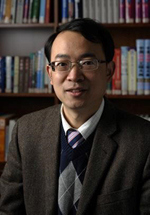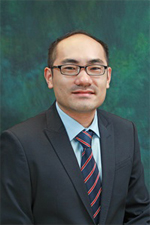题目1:基于“化学剪刀”的材料编辑技术
报告人:黄庆 研究员(中国科学院宁波材料所)
题目2:Phase transition and ferroelectricity in two-dimensional chalcogenides
报告人:赵炯 副教授(香港理工大学)
时间:2024年7月11日(周四)14:30
地点:李薰楼468会议室
题目1:基于“化学剪刀”的材料编辑技术
摘要:层状插层材料的制备通常涉及将客体物质(原子或分子)插入到天然层状材料(例如石墨、六方氮化硼和过渡金属二卤化物)的范德华间隙中。这种客体物质与宿主材料之间的相互作用可以显著改变材料的晶体结构和电子结构,从而有效调控材料的物理和化学性质,在储能、催化、信息和环境、生物等领域的应用起到至关重要的作用。然而,相对于范德华力层状材料,非范德华纳米层状材料的插层化学并没有受到足够重视。本报告将重点介绍一种针对非范德华层状三元碳化物和氮化物(称为MAX相)及其范德华多层衍生物(MXenes)的结构编辑策略,并提出“化学剪刀”的通用方法。这种策略使用氧化性的路易斯酸熔盐或者还原性的金属物质打开间隙并实现客体插层,可以获得一系列非常规化学成分和晶体结构的新型MAX相材料,以及表面端基可控的二维MXenes。该方法还可以实现二维MXenes逆向转化为三维MAX相,其化学机制在于还原性金属“化学剪刀”先敲除MXenes表面的端基,然后在层间特定晶格位放入新的原子,从而重构得到非范德华力层状材料。这种基于“化学剪刀”的结构编辑技术不仅适用于MAX相和MXene材料,而且还可应用到前过渡金属硫属化合物层状材料的结构编辑,并可创制出一类前过渡金属共价键化合物为基本结构单元的硫属化合物。“化学剪刀”结构编辑策略为层状材料的结构调控和性质研究提供了一种全新的手段,有望成为一种非稳态材料和人工材料研究的新范式。
个人简介:
 黄庆,湖南省溆浦人,研究员,博士生导师。1995-2002年求学于天津大学,获得无机非金属材料学士学位和材料学硕士学位。2002-2005年在上海硅酸盐所就读,获材料物理与化学博士学位。2005-2010年,分别在日本物质材料研究所和美国加州大学戴维斯分校开展博士后研究。2010年回国任职中国科学院宁波材料所。研究集中于极端环境能源材料的开发与应用,主要包括三元层状陶瓷的新材料创制与极端环境下物性与结构的表征,高安全能源系统复合材料的设计与评估等。已在Science、Nature Materials、JACS等期刊杂志上发表论文230余篇,合作发表著作1部,获得“中国科学院优秀导师奖”、“朱李月华优秀教师奖”和美国陶瓷学会“Richard and Patricia Spriggs Phase Equilibria Award”等荣誉称号。
黄庆,湖南省溆浦人,研究员,博士生导师。1995-2002年求学于天津大学,获得无机非金属材料学士学位和材料学硕士学位。2002-2005年在上海硅酸盐所就读,获材料物理与化学博士学位。2005-2010年,分别在日本物质材料研究所和美国加州大学戴维斯分校开展博士后研究。2010年回国任职中国科学院宁波材料所。研究集中于极端环境能源材料的开发与应用,主要包括三元层状陶瓷的新材料创制与极端环境下物性与结构的表征,高安全能源系统复合材料的设计与评估等。已在Science、Nature Materials、JACS等期刊杂志上发表论文230余篇,合作发表著作1部,获得“中国科学院优秀导师奖”、“朱李月华优秀教师奖”和美国陶瓷学会“Richard and Patricia Spriggs Phase Equilibria Award”等荣誉称号。
题目2:Phase transition and ferroelectricity in two-dimensional chalcogenides
摘要:Current electronic devices have encountered grand challenges ─ How to further scale down the device size,upgrade the integration of input/output,memory and computing units,and reduce the energy consumption. In particular,the massive communication between the computational unit and memory is hard to afford within current architecture of electronic devices and computers. New paradigm of in-memory-processing architecture has been put forward recently. Beyond current von Neumann systems,two-dimensional (2D) ferroelectrics (FE) with miniaturized dimension,high speed and high sensitivity,and robust ferroic order with memory functionalities,are superior candidates for next-generation in-memory computing devices. Moreover,the facile phase transition in 2D materials potentially offers another degree of freedom to manipulate the non-volatile memory states. Therefore,the 2D polymorphism and 2D ferroelectrics and ferroelastics indeed provide promising solutions to the aforementioned challenges.
In this presentation,we will clarify the ferroic ordering and their physical origin,and introduce how to control/manipulate the phase transition and the ferroelectricity as well as ferroelasticity in 2D and build novel devices. We applied a variety of in situ transmission electron microscopy techniques,specifically employing in situ mechanical manipulation,in situ mechanical testing,in situ electrical testing,in situ heating,and in situ electron beam control,to conduct comprehensive investigations of ferroic phase transitions and ferroic ordering in two-dimensional (2D) chalcogenides. The diverse phases observed in these ferroic 2D materials showcase unique mechanical,electrical,and other captivating physical properties. Through our study,we successfully established a direct correlation between atomic-scale structures and device-level performance,thereby enhancing our understanding and enabling practical applications of 2D functional materials.
个人简介:
 Dr Zhao Jiong is currently Associate Professor in Applied Physics Department of The Hong Kong Polytechnic University. He obtained PhD in Tsinghua University in 2012. He is the co-founder of the Atomic Electron Microscopy Centre of The Hong Kong Polytechnic University, which was established in UMF, PolyU, 2023. His main research area is low-dimensional physics especially two-dimensional materials and in situ electron microscopy. He has applied and developed in situ mechanical/electrical/heating/beam environmental tests on 1D and 2D materials, and experimentally obtained their atomic structures, chemistry and physical properties. The atomic structures and dynamical responses in atomic scale have been observed/revealed. These previous relevant research works have been published in renowned journals such as Science, Nature Nanotechnology, Nature Materials, PNAS, PRL, JACS, Nature Communications, Science Advances, etc, with Dr Zhao as the first/corresponding authors.
Dr Zhao Jiong is currently Associate Professor in Applied Physics Department of The Hong Kong Polytechnic University. He obtained PhD in Tsinghua University in 2012. He is the co-founder of the Atomic Electron Microscopy Centre of The Hong Kong Polytechnic University, which was established in UMF, PolyU, 2023. His main research area is low-dimensional physics especially two-dimensional materials and in situ electron microscopy. He has applied and developed in situ mechanical/electrical/heating/beam environmental tests on 1D and 2D materials, and experimentally obtained their atomic structures, chemistry and physical properties. The atomic structures and dynamical responses in atomic scale have been observed/revealed. These previous relevant research works have been published in renowned journals such as Science, Nature Nanotechnology, Nature Materials, PNAS, PRL, JACS, Nature Communications, Science Advances, etc, with Dr Zhao as the first/corresponding authors.



